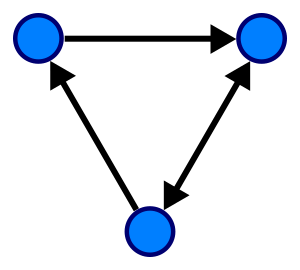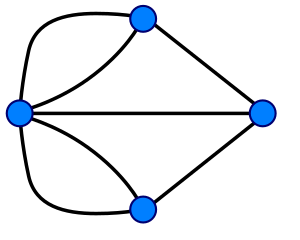Graph theory facts for kids
Graph theory is a part of math that studies special diagrams called graphs. A graph is like a map of points connected by lines. Each point is called a vertex (or vertices if there's more than one). The lines connecting them are called edges. Graphs help us understand how things are connected and solve many real-world problems.
Imagine you're trying to figure out the best way to do something. Graphs can help!
- Mail Delivery: How can a mail carrier visit every house in an area as quickly as possible? The houses could be vertices, and the streets connecting them could be edges. This is like the Chinese postman problem.
- Salesman's Route: A salesman needs to visit many customers but wants to travel the shortest distance. Finding the best route is called the Travelling Salesman Problem (often called TSP). It's a very tough problem to solve perfectly!
- Map Coloring: How many colors do you need to color a map so that no two countries sharing a border have the same color? Each country is a vertex, and an edge connects countries that share a border. This leads to the Four color theorem.
- Walking a Path: Can you draw a picture without lifting your pencil, using each line only once? In graph theory, the lines are edges, and where lines meet are vertices. The challenge is to find a path that uses every edge exactly once. This is like the famous Seven Bridges of Königsberg problem.
Contents
Different Kinds of Graphs
Graphs can come in different forms, depending on what they represent:
- Directed or Undirected: Some graphs are like one-way streets. You can only go in one direction along an edge. These are called directed graphs. If you can go both ways, it's an undirected graph.
- Weighted Graphs: Sometimes, edges have a "weight" or value. For example, on a road map, the weight could be the distance between two towns, or the toll you pay to use that road.
- Vertices and Edges: Remember, the points are called vertices, and the lines connecting them are edges. There can be no edge between two vertices, one edge, or even many edges.
- Trees: In graph theory, a "tree" is a special kind of graph. It's like a family tree or an organization chart. In a tree, you can't go in a circle. This means there's only one path between any two vertices.
History of Graph Theory
Graph theory started with a fun puzzle! In 1736, a famous mathematician named Leonhard Euler lived in a town called Königsberg (now Kaliningrad). The town had a river with an island and seven bridges connecting different parts of the city. People wondered if they could walk through the town, crossing each of the seven bridges exactly once, and end up where they started.
Euler figured out that it wasn't possible! He published a paper explaining why, and this paper is considered the very first step in the history of graph theory. He showed how to turn the bridges and land into a simple graph with vertices and edges, making the problem easier to solve.
Later, in 1878, the word "graph" was first used for these diagrams by James Joseph Sylvester.
Another famous problem in graph theory is the Four Color Problem. This problem asks: can you color any map using only four colors, so that no two areas that touch each other have the same color? It took a long time, but mathematicians finally proved that four colors are indeed enough!
Graph Theory in Perspective
Graph theory is a very important part of both mathematics and computer science. It helps us solve many problems in areas like:
- Designing computer networks
- Planning transportation routes
- Understanding social connections
- Even scheduling tasks!
Sometimes, finding the perfect answer to a graph problem can be very difficult, especially for large graphs. In those cases, people often use "approximation" methods. These methods don't find the perfect answer, but they find a very good answer that is close enough and much faster to calculate.
Images for kids
-
Graph theory in sociology: Moreno Sociogram (1953).
See also
 In Spanish: Teoría de grafos para niños
In Spanish: Teoría de grafos para niños





